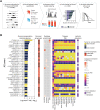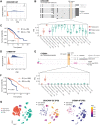A comprehensive long-read isoform analysis platform and sequencing resource for breast cancer
- PMID: 35044822
- PMCID: PMC8769553
- DOI: 10.1126/sciadv.abg6711
A comprehensive long-read isoform analysis platform and sequencing resource for breast cancer
Abstract
Tumors display widespread transcriptome alterations, but the full repertoire of isoform-level alternative splicing in cancer is unknown. We developed a long-read (LR) RNA sequencing and analytical platform that identifies and annotates full-length isoforms and infers tumor-specific splicing events. Application of this platform to breast cancer samples identifies thousands of previously unannotated isoforms; ~30% affect protein coding exons and are predicted to alter protein localization and function. We performed extensive cross-validation with -omics datasets to support transcription and translation of novel isoforms. We identified 3059 breast tumor–specific splicing events, including 35 that are significantly associated with patient survival. Of these, 21 are absent from GENCODE and 10 are enriched in specific breast cancer subtypes. Together, our results demonstrate the complexity, cancer subtype specificity, and clinical relevance of previously unidentified isoforms and splicing events in breast cancer that are only annotatable by LR-seq and provide a rich resource of immuno-oncology therapeutic targets.
Figures





References
-
- Lapuk A., Marr H., Jakkula L., Pedro H., Bhattacharya S., Purdom E., Hu Z., Simpson K., Pachter L., Durinck S., Wang N., Parvin B., Fontenay G., Speed T., Garbe J., Stampfer M., Bayandorian H., Dorton S., Clark T. A., Schweitzer A., Wyrobek A., Feiler H., Spellman P., Conboy J., Gray J. W., Exon-level microarray analyses identify alternative splicing programs in breast cancer. Mol. Cancer Res. 8, 961–974 (2010). - PMC - PubMed
Publication types
MeSH terms
Substances
Grants and funding
LinkOut - more resources
Full Text Sources
Other Literature Sources
Medical

